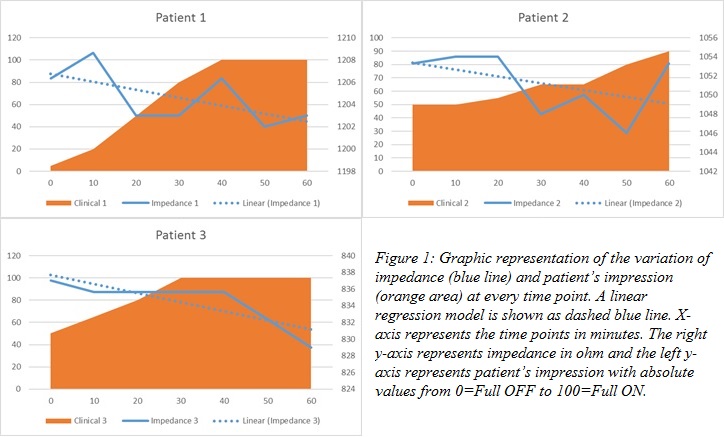Session Information
Date: Monday, June 5, 2017
Session Title: Surgical Therapy: Parkinson’s Disease
Session Time: 1:45pm-3:15pm
Location: Exhibit Hall C
Objective: To determine the possible use of electrical impedance as an easily measured surrogate measure for clinical changes in patients with Parkinson’s disease (PD) with DBS.
Background: The mainstay of symptomatic treatment in PD is the use of dopaminergic medications. The functional and biochemical effect of these agents is referred to as the “ON” state. As the effect of these agents decreases there may be recurrence of the PD motor symptoms – referred to as the “OFF” state [1]. Unfortunately, currently, there is no objective assessment of the fluctuations between the “ON” and “OFF” states except with lengthy “day-visits” and observations. These can be cumbersome to patients and not available in most centers due to time and resource constraints. Identifying easy to obtain objective measures for the clinical “ON” and “OFF” states in PD DBS patients could be clinically relevant to care. Voltammetry allows measurement of dopamine concentration by altering the redox state of dopamine, inducing an electric current [2]. Impedance, a measure of resistance, is inversely related to current. We hypothesize that impedance is modulated by the dopamine concentration at the site of the DBS electrode.
Methods: A prospective single center pilot study was conducted. Patients with already implanted Medtronic Activa DBS presenting for their yearly DBS visit were selected. Patients presented in the “OFF” state withholding dopaminergic medications for at least 12 hours. Patients were asked to take their regular dopaminergic medication dose (time 0). Serial impedance measurements were recorded at times 0, 10, 20, 30, 40, 50 and 60 min. At each time point, patients rated the dopaminergic medication “on” effects using a visual analog scale.
Results: The study is ongoing and 3 patients have been recruited. Preliminary analysis reveals a trend towards a negative correlation between impedance and the patient’s impression of medication effects (figure 1). We will present the updated data at the meeting.
Conclusions: These preliminary results are encouraging as they show a trend toward negative correlation between impedance (easily measured in DBS patients) and the patient’s impression of dopaminergic medication effects. We expect an improvement in statistical significance as we recruit a higher number of patients (given the large number of patients at our center we expect a much higher number by the time of the MDS meeting).
References: [1] Aquino CC, Fox SH. Clinical spectrum of levodopa-induced complications. Mov Disord. 2015 Jan;30(1):80-9.
[2] Kruk, Z. L., et al. “Real time measurement of stimulated dopamine release in the conscious rat using fast cyclic voltammetry: dopamine release is not observed during intracranial self stimulation.” Journal of neuroscience methods 79.1 (1998): 9-19.
To cite this abstract in AMA style:
W. Deeb, J. Shute, M. Okun. Electrode Impedance as a marker for “on” and “off” states in a Deep Brain Stimulation cohort: A pilot study [abstract]. Mov Disord. 2017; 32 (suppl 2). https://www.mdsabstracts.org/abstract/electrode-impedance-as-a-marker-for-on-and-off-states-in-a-deep-brain-stimulation-cohort-a-pilot-study/. Accessed December 30, 2025.« Back to 2017 International Congress
MDS Abstracts - https://www.mdsabstracts.org/abstract/electrode-impedance-as-a-marker-for-on-and-off-states-in-a-deep-brain-stimulation-cohort-a-pilot-study/

